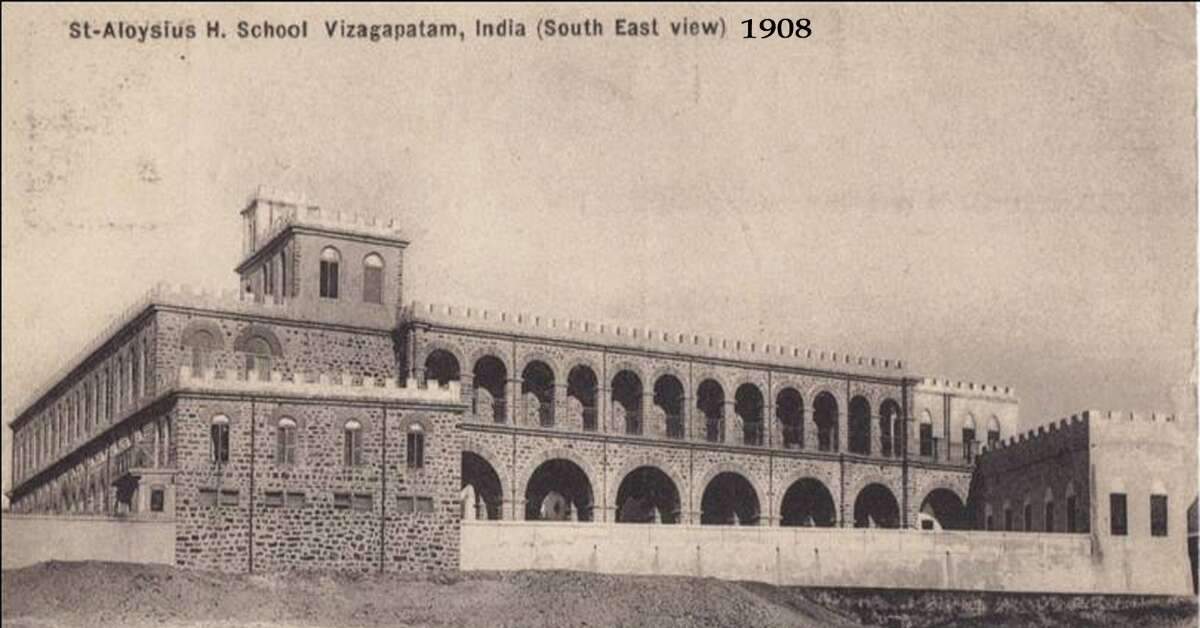

In the late 1800s, Britain saw the emergence of Industrial Schools, a concept that eventually reached colonial India. These institutions aimed to educate and equip young children with the skills needed for various industrial sectors, evolving in response to the rising demand for skilled labour during the Industrial Revolution. By 1890, this movement had reached Vizag, leading to the establishment of its first Industrial School, whose lasting influence extended to diverse fields such as carpentry, mechanical and automotive repairs, construction, shipbuilding, electrical work, defence, and more. This is the untold story of this esteemed institution, as narrated by heritage writer John Castellas.
Industrial Education was the quest of Vizag’s Bishop Tissot (Bishop 1886 – 1890) of the Missionaries of St Francis de Sales (MSFS). Bishop Tissot, who had founded St Aloysius High School, also wished to establish an Industrial School on a small scale in connection with St Aloysius. Bishop Tissot’s inspiration came from St Francis de Sales who is said to have – during his mission in Chablais France – had started at Thorens, “la Sainte Maison”, or Holy House with a training centre and a section for training craftsmen. It is no wonder his MSFS disciples sought to begin the ”la Sainte Maison” training centre in Vizag to provide technical skills to the students who were weak in academic studies. But the want of trained teachers coupled with the want of funds prevented him from carrying out his long-cherished plan. Before his sudden death in 1890, one of Bishop Tissot’s last instructions for his clergy was that they should make a beginning on an Industrial School.
At the time of Bishop Tissot’s death in 1890, the Catholic District of Vizagapatam was under the administration of Rev Jean Marie Clerc who would himself succeed Rev Tissot as the Bishop of Vizagapatam. The Bishop Clerc decided to open the first workshop on a very small scale. He approached one of Rev Tissot’s friends, Rajah Pusapati Ananda Gajapati Raju, the Rajah of Vizianagaram who, though a Hindu, had a great respect for the educational work of the Catholic Missionaries. He very graciously provided a small site near the Customs Office and at a cost of Rs 7,000. He had a large hall built there which could be used as a workshop. Bishop Clerc had also secured Rs 6,000 in donations from Europe to purchase the equipment. The new institution called
‘Bishop Tissots Memorial School of Industry’ was opened with 12 apprentices learning carpentry and rattan work under Brother Guersion Von Haeften in December 1890.Around 1890, large Railway Workshops were built at Waltair Railway Station, giving employment to many young men. In the orphanage attached to St Aloysius’ school, there were many boys who had an aptitude for technical and mechanical skills rather than schoolbooks and disliked the routine European style of education imparted in the school. Selected boys were given 3 years of Non-Formal Training. They were awarded certificates from the Madras Government Director for Technical Education after completion of the course. These certificates enabled them to get employment opportunities in the Government and Private sectors. Some boys, who were not eligible for the diploma certificates would go to In-Formal Educational Programmes. Students who passed at least upper primary studies were admitted to the Industrial School for training. Courses were oriented towards employment, self-employment and self-reliance.
In 1894-95, Fr Eugene Ailloud led the school, and a small forge was started to do some ironwork besides carpentry. With the railways demanding more skilled labour, most of the early apprentices were either residents of Vizagapatam or from nearby villages. The MSFS missionaries in the other stations began to complain that they could not send their boys to the technical school because of a lack of boarding arrangements. The matter was referred to the Bishop who agreed to use an old house in the St Anne’s Cathedral compound for the purpose.
In 1906, Fr Contact, the Principal of St Aloysius High School acquired a piece of land from the Municipality which was adjacent to the school building. It was on this plot of land that a strong permanent building was started for the Industrial School. As a result of Bishop Clerc’s visit to Europe in 1905, he recruited Brother Emile Maillard, a clever engineer from Switzerland who arrived at Vizagapatam in January 1906. The arrival of Brother Emile was the new start of St Aloysius’ workshop and industrial school – the first in Vizag. Under his direction, the Industrial School became known as the prestigious workshop where all kinds of machines and motors were repaired.
From the years 1906 to 1908, Brother Emile built the workshop and some residential rooms. In 1909, machinery worth 118,000 Francs was installed, and real engineering work was started. Cars were brought to the Industrial School for repairs and servicing. He never refused any car that was brought to him, because he wanted the apprentices to learn as and when he repaired the cars. The popularity of the technical school was promoted by the prominent people who brought their cars for repair. In 1910, the local Rajahs had a car each and Brother Emile was the only one capable of repairing them. The first Electric Lights in Vizag were switched on at St Aloysius on 13 May 1908, when Brother Emile of the Industrial School demonstrated electric lighting of the new school building, for its opening by Maharani Lady Gajapathi Rao.
By 1914, the Collector of Vizagapatam and other officials brought cars in for repairs. Brother Emile recruited candidates for apprenticeships and trained them well. Theory was demonstrated with plenty of practice and apprentices who spent a few years in the school started workshops of their own. Others were readily employed in the Railways, public works, Surveys, Ports, Posts & Telegraph. The name of the school was changed to the St Aloysius’ Industrial School and was recognised by the Government. Today, this first Industrial School functions as the St Aloysius’ Non-Formal Technical School on the Beach Road, Vizag. Brother Emile had plans for a larger workshop and in 1917 an application was made to the Government, strongly recommended by the Inspector of Industrial Schools, for the acquisition of the site of some 3000 square yards adjacent to the workshop. As that site was occupied partly by the fishermen and partly by the Coromandel Company it took a long time to obtain. But in January 1920, the new site of 3,404 square yards was handed over to Father Cowman, the Correspondent of the Industrial School.
In 1921, Brother Emile went to Europe to recuperate his health and returned in 1922. He brought with him many new and second-hand machines. Among them, there was a German diesel motor, one of the first to have come to India. It gave the motive electric power needed for the workshop till 1936. After a long illness, on 2nd February 1929, Vizag’s Engineering Expert, Brother Emile, died at the age of 50 and left a legacy that still remains with the St Aloysius Industrial School.
What followed was a protracted struggle with the Government which would not accept the technical capability of some of Brother Emiles’ colleagues. Mr Fiffe, Inspector of Industrial Schools, threatened to withdraw recognition unless a qualified engineer was head of the technical training. Father Cowman, Father Contat, Bro Ambrose Xavier, and Fr Jules Rey followed; a former apprentice Mr Castel Nuovo was hired but the authorities were not satisfied. The workshop was leased out to Addison and Luke, a Madras Motor Company, on 27th March 1930 on a 5-year agreement. They sold and serviced their motor vehicles and obtained Government approval to continue training. The agreement was for Rs 8,700/- per annum to be paid to the MSFS and to return everything, equipment and buildings to their original state.
The MSFS resumed charge of the workshop and Industrial School on 1st June 1935 from Addison and Company. Father Joseph Baud, the Principal of St Aloysius’ School managed the affairs of the workshop with Brother Ambrose Xavier to help him. In 1937, the school became the sales and service agency for Hillman Motor Cars. Father Curzillat officially took charge of the workshop and Industrial School in January 1937 and his genius and hard work brought back the glory of the institution like it had in the days of Brother Emile. New trades such as electrical, welding, fitting and machining were introduced.
Soon, the Second World War broke out, and the Industrial School became a training centre for East Coast Battalion army volunteers in Vizag. A part of the workshop and some machines were under requisition from the Government. The Industrial School was the centre to maintain the equipment and vehicles used for local defence and for the protection of the civilians. The Royal Air Force (RAF) set up their maintenance and repair organisation in the workshop. The distribution of steel in Vizagapatam and East Godavari Districts became the responsibility of the workshop.
St Aloysius’ Industrial School supplied not only the needed materials but also erected the roofs of many churches and schools in various places such as Salur, Parvathipuram, Palakonda, Bobbili, St Anthony’s High School, St Aloysius’ School etc. The Ross Hill Chapel relied totally on the Industrial School for all its construction and maintenance needs.
The St Aloysius Industrial School has been an essential part of the technical growth of Vizag from the early days of railways in the 1890s, motor transportation in the 1920s, the construction of Vizag Harbour in the 1930s and the start of military aviation and ship-building in the 1940s. Above all, the greatest service of the Industrial School was the early recognition of the need for a technically skilled workforce and providing the necessary training of hundreds of skilled men and helping them to find jobs in the boom industries of an industrially developing Vizag in the 20th century.
Written by John Castellas whose family belonged to Vizag for 5 generations. Educated at St Aloysius, migrated to Melbourne, Australia in 1966, former General Manager Engineering at Boeing & Qantas Airways, in retirement Lecturers in Aviation Management at Swinburne University and is a Vizag aficionado. John authors heritage articles for YoVizag and Waltair Times and has contributed to Coffee Table Books for the Waltair Club and Andhra Medical College. He can be contacted at jcastell@ozemail.com.au
Stay tuned to Yo! Vizag website and Instagram for more such heritage stories.
Gifts tell a lot about a person. One of the five love languages, gift giving,…
Growing up in India, most of us are no strangers to superstitions and omens. Warnings…
The Sunrisers Hyderabad (SRH) vs Mumbai Indians (MI) IPL clash tonight at Mumbai’s iconic Wankhede…
In a disturbing incident in Gajuwaka in Visakhapatnam, a 37-year-old traveler from Assam was beaten…
In a strategic move to transform Visakhapatnam into a leading IT hub, the Andhra Pradesh…
Sci-fi has always been an integral part of cinema and media. Whether it's Star Wars,…
Leave a Comment